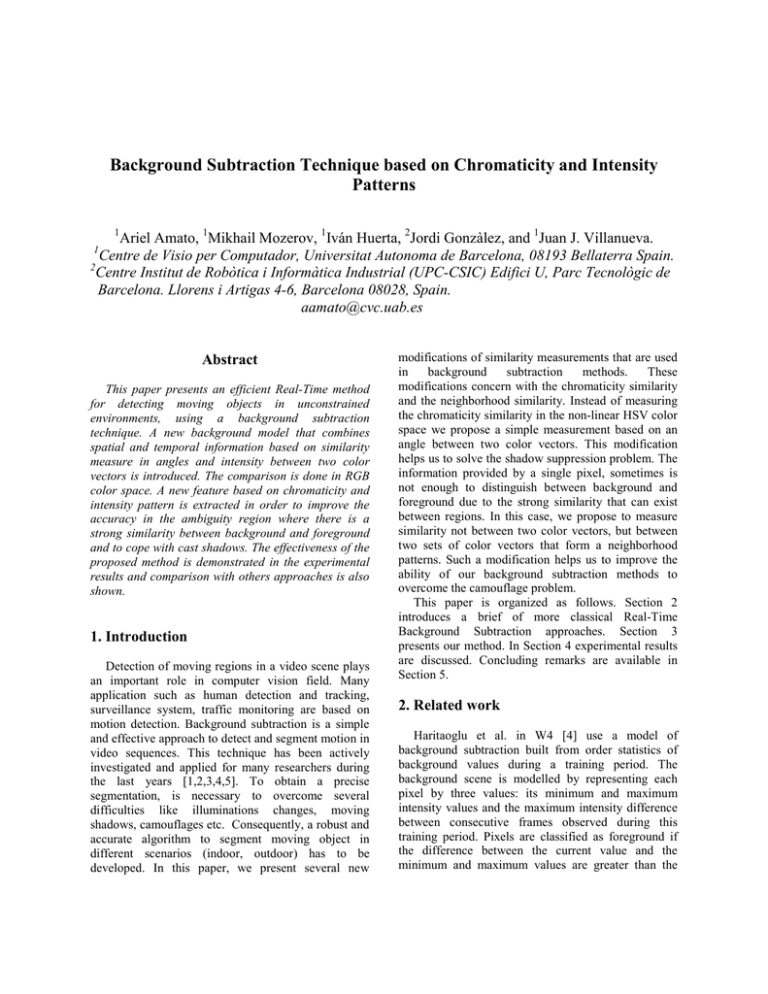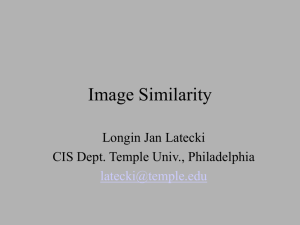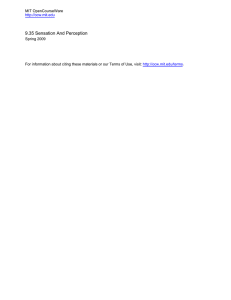Background Subtraction Technique based on Chromaticity
advertisement

Background Subtraction Technique based on Chromaticity and Intensity
Patterns
1
Ariel Amato, 1Mikhail Mozerov, 1Iván Huerta, 2Jordi Gonzàlez, and 1Juan J. Villanueva.
Centre de Visio per Computador, Universitat Autonoma de Barcelona, 08193 Bellaterra Spain.
2
Centre Institut de Robòtica i Informàtica Industrial (UPC-CSIC) Edifici U, Parc Tecnològic de
Barcelona. Llorens i Artigas 4-6, Barcelona 08028, Spain.
aamato@cvc.uab.es
1
Abstract
This paper presents an efficient Real-Time method
for detecting moving objects in unconstrained
environments, using a background subtraction
technique. A new background model that combines
spatial and temporal information based on similarity
measure in angles and intensity between two color
vectors is introduced. The comparison is done in RGB
color space. A new feature based on chromaticity and
intensity pattern is extracted in order to improve the
accuracy in the ambiguity region where there is a
strong similarity between background and foreground
and to cope with cast shadows. The effectiveness of the
proposed method is demonstrated in the experimental
results and comparison with others approaches is also
shown.
1. Introduction
Detection of moving regions in a video scene plays
an important role in computer vision field. Many
application such as human detection and tracking,
surveillance system, traffic monitoring are based on
motion detection. Background subtraction is a simple
and effective approach to detect and segment motion in
video sequences. This technique has been actively
investigated and applied for many researchers during
the last years [1,2,3,4,5]. To obtain a precise
segmentation, is necessary to overcome several
difficulties like illuminations changes, moving
shadows, camouflages etc. Consequently, a robust and
accurate algorithm to segment moving object in
different scenarios (indoor, outdoor) has to be
developed. In this paper, we present several new
modifications of similarity measurements that are used
in
background
subtraction
methods.
These
modifications concern with the chromaticity similarity
and the neighborhood similarity. Instead of measuring
the chromaticity similarity in the non-linear HSV color
space we propose a simple measurement based on an
angle between two color vectors. This modification
helps us to solve the shadow suppression problem. The
information provided by a single pixel, sometimes is
not enough to distinguish between background and
foreground due to the strong similarity that can exist
between regions. In this case, we propose to measure
similarity not between two color vectors, but between
two sets of color vectors that form a neighborhood
patterns. Such a modification helps us to improve the
ability of our background subtraction methods to
overcome the camouflage problem.
This paper is organized as follows. Section 2
introduces a brief of more classical Real-Time
Background Subtraction approaches. Section 3
presents our method. In Section 4 experimental results
are discussed. Concluding remarks are available in
Section 5.
2. Related work
Haritaoglu et al. in W4 [4] use a model of
background subtraction built from order statistics of
background values during a training period. The
background scene is modelled by representing each
pixel by three values: its minimum and maximum
intensity values and the maximum intensity difference
between consecutive frames observed during this
training period. Pixels are classified as foreground if
the difference between the current value and the
minimum and maximum values are greater than the
values of the maximal interframe difference. However,
this approach is rather sensitive to shadows and
lighting changes, since the only illumination intensity
cue is used.
Horprasert et al. [5] implement a statistical color
background algorithm, which use color chrominance
and brightness distortion. The background model is
built using four values: the mean, the standard
deviation, the variation of the brightness and
chrominance distortion. However, the chromaticity
noise model in this paper is not correct. Indeed,
according to the logic of the thresholds definition the
chromaticity noise does not depend on the change of
illumination, but such an assumption is wrong in
general.
Kyungnam Kim et. al [3] use a similar approach,
but they obtain more robust motion segmentation in the
presents of the illumination and scene changes using
background model with codebooks. The codebooks
idea gives the possibility to learn more about the model
in the training period The authors propose to cope with
the unstable information of the dark pixels, but still
they have some problems in the low and the high
intensity regions.
Stauffer and Grimson [6] address the low and the
high intensity regions problem by using a mixture of
Gaussians to build a background color model for every
pixel.
Pixels
from
the
current
frame
are checked against the background model by
comparing them with every Gaussian in the model
until a matching Gaussian is found. If so, the mean and
variance of the matched Gaussian is updated, otherwise
a new Gaussian with the mean equal to the current
pixel color and some initial variance is introduced into
the mixture.
Cucchiara et al. [1] use a model in Hue-SaturationValue (HSV) and stress their approach in shadow
suppression. The idea is that shadows change the hue
component slightly and decrease the saturation
component significantly. In the HSV color space a
more realistic noise model can be done. However, this
approach also has drawbacks. The similarity measured
in the non-linear HSV color space, as a result the noise
value seems to depend on the chromaticity value of the
background color and such an assumption is not
generally correct. Also, the color space transformation
from RGB to HSV increases complexity of the
approach and decreases the calculation error.
3. Proposed Algorithm
3.1. Similarity Measurements
To compare a background image with a current frame
we use four similarity measurements. Those are:
• Angular similarity measurement Δθ between two
color vectors in the RGB color space p1 and p2, which
is defined as follows
⎛ pp
Δθ ( p1 , p 2 ) = Cos −1 ⎜ 1 2
⎜p p
⎝ 1 2
⎞
⎟⎟ .
⎠
(1)
• Intensity similarity measurement ΔI between two
color vectors in the RGB color space p1 and p2
ΔI ( p1 , p 2 ) = p1 − p 2 .
(2)
With each of the described similarity measurements we
associate a threshold function
⎧1 if Δθ > T θ
T θ ( Δθ ) = ⎨
,
⎩0 else
(3)
I
⎪⎧1 if ΔI > T
,
TI ( ΔI ) = ⎨
⎪⎩0 else
where Tθ and TI are intrinsic parameters of the
threshold functions of the similarity measurements.
To describe a neighbourhood similarity measurement
let us first characterize the index vector
x=(n,m)t ∈Ω ={0,1,.n,..N; 0,1,.m,…M}, which define
the position of a pixel in the image. Also we need to
name the neighbourhood radius vector
w=(i,j)t ∈W ={-W,..0,1,i,..W; -W,..0,1,.j,…W}, which
define the positions of pixels that belong to the
neighbourhood relative any current pixel. Indeed, the
domain W is just a square window around a chosen
pixel.
• Angular neighborhood similarity measurement ηθ
between two sets of color vectors in the RGB color
space p1+w and p2+w (w∈W) can be written as
ηθ ( p1x + w , p x2 + w ) =
∑ T θ ( Δθ ( p
w∈W
1
x+w
)
, p x2 + w ) , (4)
where the functions Tθ and Δθ are defined in Eq. (3)
and Eq. (1) respectively.
• Intensity neighborhood similarity measurement
μθ between two sets of color vectors in the RGB color
space p1+w and p2+w (w∈W) can be written as
μθ ( p1x + w , p x2 + w ) =
∑ TI ( ΔI (p
1
x+w
w∈W
)
, p x2 + w ) ,
(5)
where the functions TI and ΔI are defined in Eq. (3)
and Eq. (2) respectively.
With each of the neighbourhood similarity
measurements we associate a threshold function
⎧1
Tηθ (ηθ ) = ⎨
⎩0
⎧1
T μI (μI ) = ⎨
⎩0
if Δθ > T ηθ
,
else
if ΔI > T μ I
,
else
(6)
where Tηθ and TμI are intrinsic parameters of the
threshold functions of the neighborhood similarity
measurements.
3.2. Background Modeling
Our background model (BG) will be represented
with two classes of components one we call running
components (RC) and another we call training
components (TC). The RC is a color vector in RGB
space and only this component can be updated in
running process. The TC is a set of fixed thresholds
values obtained during the training.
The background model is represented by
θ
I
ηθ
μI
BGx = {{p x } , {Tx , Tx , Tx , Tx , W}} ,
(7)
where Txθ is maxima of the chromaticity variation
(temporal-base); TxI is maxima of the intensity variation
(temporal-base); Txηθ
is the chromaticity pattern
μI
threshold (spatial-base); Tx is the intensity pattern
threshold (spatial-base); W is the half size of the
neighbourhood window.
To obtain the background parameters in the definition
of Eq. (7) the training process has to be performed.
This first step consists of estimating the value of the
RC and TC during the training period.
To initialize our BG we put the RC = { p 0x } as the
initial frame and these values are supported during all
training process. To estimate Txθ and TxI during the
training period, we compute the intensity and
chromaticity difference between a background image
pixel and the related pixel in the current frame
belonging to the training process
{Δθ ( p , p )} ,
max {ΔI ( p , p )} ,
{
}
Txθ = max
f ∈{1,2,.. F }
TxI =
f ∈ 1,2,.. F
0
x
0
x
f
x
f
x
(8)
where F is the number of frames in the training period.
In this paper we consider the simplified version of our
algorithm. In this case the spatial-base thresholds Txηθ
and Txηθ we put as 1 for the neighbourhood radius
equalling 1 (the 3x3 square windows), and for all
pixels in the frame. However, locally adaptive version
of our approach allows estimating this parameter in
each pixels like the temporal-based thresholds.
After the initialization has been done the following
equations show how to obtain the TC values. These
values are estimated in the Running and Foreground
Classification Process.
Our classification rules are enunciated in two steps:
Step One: This step is concentrate on the pixels that
have strong chromaticity and intensity differences with
the background, it means that the following rule
expression have to be TRUE or 1
(
)
(
)
f
θ
f
I
Tθ Δθ ( pbg
∩ TI ΔI ( pbg
= 1; (9)
x , px ) | γ T
x , px ) | γ T
where γ is an experimental scale factor for the training
set thresholds and the value of this factor greater than
1. In this case the tested pixel is directly classified like
foreground. Otherwise the classification will be done
in the next step.
Step Two: Due to the angular similarity measurement
is inaccurate for low intensity color vectors, we define
a confidence threshold Tcf., where if the vectors are
greater than Tcf the classification will be done
according to the rule of Eq. (10) otherwise according to
the rule in Eq. (11).
(
)
(
TI ( ΔI ( p , p ) ) ∩ ( ΔI ( p , p ) > 0 )
∪T μ I ( μ I ( p , p ) ) = 1;
)
f
bg
f
T θ Δθ ( p bg
x , p x ) ∪ Tηθ ηθ ( p x + w , p x + w ) = 1;
bg
x
f
x
bg
x+w
bg
x
f
x
f
x+w
(10)
(11)
Updating Models: The update of the background
follows the next rule: put the current pixel value to the
BG if this pixel is not classified as foreground.
4. Experimental Results
We applied the proposed algorithm in several
videos
scenes,
under
different
conditions
(indoor/outdoor). In order to evaluate the performance
of the proposed technique we generated a ground-truth
segmentation masks by manual segmentation. Due to
the numbers of frames tested, from different sequences
was considerably high, we choose 20 frames per scene
which these were sampled in such way to maintain the
same inter-frame distance from the beginning to the
end of the sequence and four different sequence has
been evaluated. Using the same sequences we
implements algorithms from others authors [3,4,5,6] to
obtain a general comparison of our method.
Two quantitative expressions were utilized to
evaluate segmentation process, False Positive Error
(FPE) and False Negative Error (FNE). Eq (12). The
FPE means that the background pixel was set as a
Foreground and FNE the foreground pixels that were
set as a Background.
(a)
(b)
Error(%)=numbers of misclassification pixels.100 (12)
numbers of correct foreground pixels
False Positive Error
Our Approach
35
Kim
30
(c)
(d)
Fig. 2 (a) Original Image, (b) Our method, (c)
Stauffer and Grimson method (d). K Kim method,
% Error
25
Horprasert
20
15
w4
10
Acknowledgements
5
Stauffer and Grimson
0
1
2
3
4
Sequences
(a)
False Negative Error
Our Approach
25
Kim
% Error
20
15
Horprasert
10
w4
This work is supported by EC grants IST-027110 for
the HERMES project and IST-045547 for the VIDIvideo project, and by the Spanish MEC under projects
TIN2006-14606 and CONSOLIDER-INGENIO 2010
MIPRCV CSD2007-00018. Jordi Gonzàlez also
acknowledges the support of a Juan de la Cierva
Postdoctoral fellowship from the Spanish MEC.
References
5
Stauffer and Grimson
0
1
2
3
4
Sequences
(b)
Fig. 1 Segmentation errors. a) FPE, b) FNE
Fig. 2 shows the comparison between our techniques
and some well known methods. It can be seen that our
method performs better in terms of segmenting
camouflage areas and suppressing strong shadows.
5. Conclusions
We proposed a Background Subtraction algorithm
whose effectiveness was demonstrated in the comparison with other methods. The background model
combines spatial and temporal information based on
similarity measure in angle and intensity. Also, a
feature based on chromaticity and intensity pattern is
extracted in order to resolve the ambiguity that exists
between similar regions and to cope with moving
shadows.
[1]
R. Cucchiara, C. Grana, M. Piccardi, A. Prati, & S.
Sirotti, Improving Shadow Suppression in Moving Object
Detection with HSV Color Information, Proc. Intelligent
Transport Systems, 2001, 334–339.
[2 ] Karaman, Mustafa; Goldmann, Lutz; Yu, Da; Sikora,
Thomas. “Comparison of static background segmentation methods” Visual Communications and Image
Processing 2005. Volume 5960, pp. 2140-2151 (2005).
[3] K. Kim, T. H. Chalidabhongse, D. Harwood and L.
Davis, "Real-time Foreground-Background Segmentation using
Codebook Model", Real-time Imaging,
Volume 11, Issue 3, Pages 167-256 (June 2005)
[4] I. Haritaoglu, D. Harwood and L. S. David,“W4: RealTime Surveillance of People and Their Activities”IEEE
Trans. Pattern Anal. Mach. Intell. Vol.22. pp. 809-830
[5] T. Horprasert, D. Harwood, & L. Davis, A Statistical
Approach for Real-time Robust Background Subtraction
and Shadow Detection, Proc. IEEE Conference on
Computer Vision, FRAME-RATE Workshop, 1999.
[6] Stauffer C, Grimson WEL. Adaptive background mixture
models for real-time tracking. IEEE International Conference on Computer Vision and Pattern Recognition 1999.





